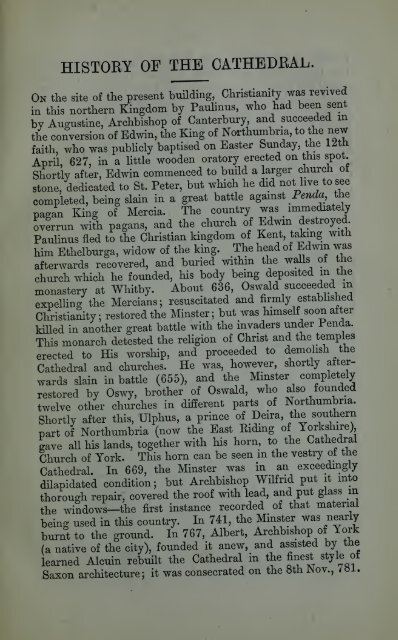practicalguideto00unse_0
You also want an ePaper? Increase the reach of your titles
YUMPU automatically turns print PDFs into web optimized ePapers that Google loves.
HISTORY OF THE CATHEDEAL.<br />
On the site of the present building, Christianity was revived<br />
in this northern Kingdom by Paulinus, who had been sent<br />
by Augustine, Archbishop of Canterbury, and succeeded in<br />
the conversion of Edwin, the King of Northumbria, to the new<br />
faith, who was publicly baptised on Easter Sunday, the 12th<br />
April, 627, in a little wooden oratory erected on this spot.<br />
Shortly after, Edwin commenced to buUd a larger church ot<br />
stone, dedicated to St. Peter, but which he di.d not live to see<br />
completed, being slain in a great battle agamst Pewcto, the<br />
pagan King of Mercia. The country was immediately<br />
overrun will pagans, and the church of Edwm destroyed<br />
Paulinus fled to the Christian kingdom of Kent, taking with<br />
him Ethelburga, widow of the king. The head of Edwin was<br />
afterwards recovered, and buried within the walls of the<br />
church which he founded, his body being deposited m the<br />
monastery at Whitby. About 636, Oswald succeeded in<br />
expelling the Mercians; resuscitated and firmly established<br />
Christianity; restored the Minster; but was himself soon after<br />
killed in another great battle with the invaders under Penda.<br />
This monarch detested the religion of Christ and the temples<br />
erected to His worship, and proceeded to demolish the<br />
Cathedral and churches. He was, however, shortly afterwards<br />
slain in battle (655), and the Minster completely<br />
restored by Oswy, brother of Oswald, who also founded<br />
twelve other churches in different parts of Northumbria.<br />
Shortly after this, Ulphus, a prince of Deira, the southern<br />
part of Northumbria (now the East Eiding of Yorkshire)<br />
gave all his lands, together with his horn, to the Cathedral<br />
Church of York. This horn can be seen in the vestry ot the<br />
Cathedral. In 669, the Minster was in an exceedingly<br />
dilapidated condition; but Archbishop Wilfrid put it into<br />
thorough repair, covered the roof with lead, and put glass m<br />
the windows—the first instance recorded of that material<br />
being used in this country. In 741, the Minster was nearly<br />
burnt to the ground. In 767, Albert, Archbishop of York<br />
(a native of the city), founded it anew, and assisted by the<br />
learned Alcuin rebuilt the Cathedral in the finest style of<br />
Saxon architecture; it was consecrated on the 8th JNov.,















